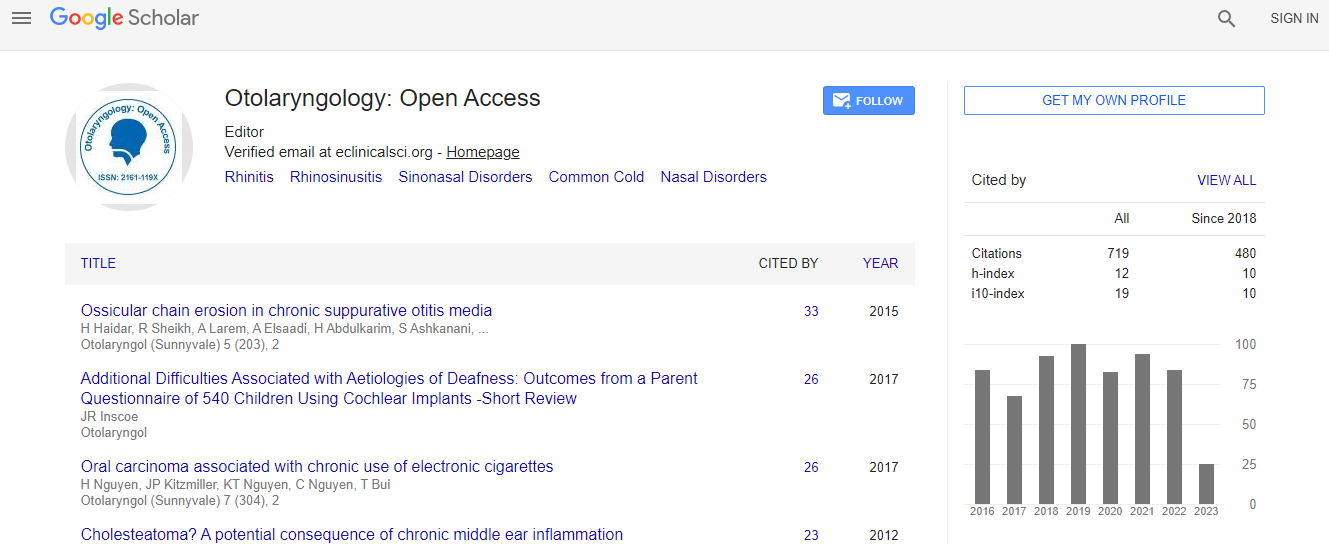Our Group organises 3000+ Global Conferenceseries Events every year across USA, Europe & Asia with support from 1000 more scientific Societies and Publishes 700+ Open Access Journals which contains over 50000 eminent personalities, reputed scientists as editorial board members.
Open Access Journals gaining more Readers and Citations
700 Journals and 15,000,000 Readers Each Journal is getting 25,000+ Readers
Google Scholar citation report
Citations : 925
Otolaryngology: Open Access received 925 citations as per Google Scholar report
Otolaryngology: Open Access peer review process verified at publons
Indexed In
- Index Copernicus
- Google Scholar
- Sherpa Romeo
- Open J Gate
- Genamics JournalSeek
- RefSeek
- Hamdard University
- EBSCO A-Z
- OCLC- WorldCat
- Publons
- Geneva Foundation for Medical Education and Research
- ICMJE
Useful Links
Recommended Journals
Related Subjects
Share This Page
A rare case of Camel bite to the face resulting in injuries to parotid duct facial nerve, and globe
Joint Event on 4th European Otolaryngology-ENT Surgery Conference & 3rd International Conference on Craniofacial Surgery
Mohamed A. Al-Ali, Korana Balac, Tahra AlMahmoud and Fikri Abu-Zidan
UAE University, UAE
ScientificTracks Abstracts: Otolaryngol (Sunnyvale)
Abstract
Introduction: Camel bites are relatively uncommon. They are more common during the rutting season where male camels become more aggressive. Hereby we report a unique case of a 25-year-old man who was repeatedly bitten to his face and neck by an aggressive camel that resulted in left eye evisceration, parotid duct injury, and facial nerve injury.Presentation of case: A 25-year-old male camel caregiver presented with history of camel bite to the left side of his head and neck. There were multiple laceration wounds on the left side of his face and neck. Maxillofacial CT showed a fracture of the medial orbital wall with sagging of medial rectus muscle into the fracture space, medial rectus muscle hematoma, fracture of lacrimal bone and displacement of piece of it into the orbit, left preseptal hematoma, complete opacification of left intraocular content (hemorrhage), crystalline lens was not identified, and the eye appeared as one chamber with loss of the eyewall integrity. He underwent an emergency wound exploration and debridement. There was a massive corneal laceration with expulsion of the eye content. Salvaging the left eye was not possible, and evisceration of the eye was performed. The left cheek wound site revealed macerated muscle with a partially transected Parotid duct which was approximated. On a postoperative day 6, the patient developed a small left-sided salivary fistula. This was managed with Hyoscine tablets, transdermal scopolamine, and pressure dressing. The patient was discharged home on day 9 in a good general condition. A follow up at one month showed a satisfactory scar, completely healed salivary fistula, and a residual weak upper lip function.
Conclusion: Camel bite injuries to the face may result in serious long-term sequelae. Extreme care should be taken when dealing with camels, especially during the rutting season. The details of the case and management of parotid duct injury will be discussed.
Recent Publications
1. Al-Ali MA, Hefny AF, Abu-Zidan FM. Head, face and neck camel-related injuries: Biomechanics and severity. Injury. 2019 Jan;50(1):210-214. doi:10.1016/j.injury.2018.11.029.
2. Al-Ali MA, Hefny AF, Idris KM, Abu-Zidan FM. Cervical necrotizing fasciitis: an overlooked diagnosis of a fatal disease. Acta Otolaryngol. 2018 Apr;138(4):411-414. doi: 10.1080/00016489.2017.1393841.
Biography
Dr. Mohamed Al-Ali has completed his residency training in Otolaryngology, Head & Neck Surgery from the Sahlgrenska University Hospital, the University of Gothenburg, Sweden in 2014. He is a fellow of the European Board of Otolaryngology- Head and Neck Surgery. He works as an Assistant Professor at the department of Surgery/ Otolaryngology, College of Medicine and Heath Sciences, UAE University. He is a consultant Otolarngologist in Al Ain Hospital, Abu Dhabi, and UAE.
E-mail: mams.alali@gmail.com

 Spanish
Spanish  Chinese
Chinese  Russian
Russian  German
German  French
French  Japanese
Japanese  Portuguese
Portuguese  Hindi
Hindi 
